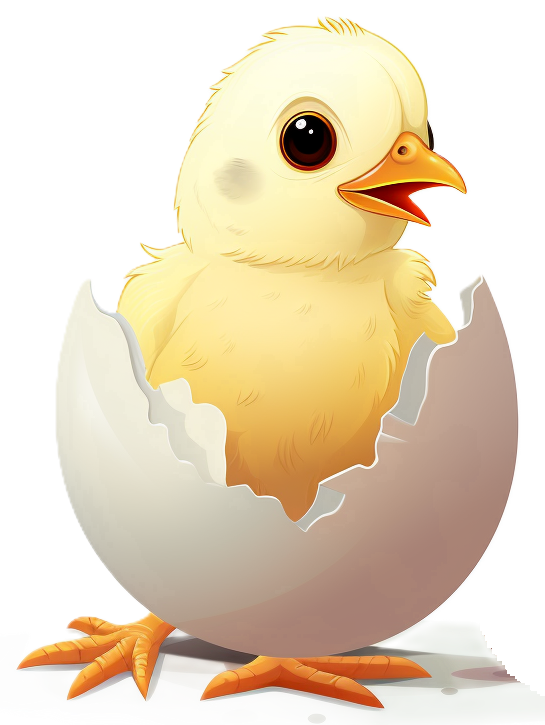Amniote Egg Coloring

Which Came First, the Chicken or the Egg? (Google Doc) Animals have been laying eggs for millions of years; snails, fish, and many other critters produce eggs from which their young hatch. The egg of the reptile is a special kind of egg. It has a shell to help prevent drying, and a series of membranes that surround the developing chick. This kind of egg is unique to the amniotes, a group that includes turtles, lizards, birds, dinosaurs, and mammals. The last name in that list, the mammals, may have surprised you since most mammals do not lay eggs, but the earliest mammals laid eggs, and a few, such as the duck-billed platypus still do.
To understand this, you must first understand the egg itself. Inside the egg are a series of fluid-filled membranes which permit the embryo to survive: the amnion, allantois, yolk sac, and chorion. Surrounding and protecting the embryo is the amnion, filled with amniotic fluid, and providing the embryo with a watery environment. Recall that amphibians had to return to water to lay eggs, reptiles were the first group to live completely on the land. The amniote egg allowed them to place their eggs on dry land, the water (amniotic fluid) was IN the egg. Color the amnion dark blue and the fluid inside surrounding the embryo light blue. Color the embryo red.
The allantois and yolk are attached to the reptile embryo. The allantois performs two very important functions for the embryo, providing for gas diffusion, and removal of wastes. Color the allantois green. Food for the developing embryo comes from the yolk sac, which reduces in size as the embryo matures. Color the yolk sac yellow. goes here.
The allantois and yolk are attached to the reptile embryo. The allantois performs two very important functions for the embryo, providing for gas diffusion, and removal of wastes. Color the allantois green. Food for the developing embryo comes from the yolk sac, which reduces in size as the embryo matures. Color the yolk sac yellow.
Surrounding all the other membranes is the chorion, providing an overall enclosure for the young. Around the chorion is the albumin, or "white" of the egg. The outer shell protects the whole egg, prevents drying while still permitting air to reach the embryo. Color the albumin pink. Because of this shell, all reptiles (and birds) must reproduce using internal fertilization. An air space, visible at the right of the diagram, provides an extra internal buffer for environmental conditions. Color the air space purple. Locate the chorion (indicated only as a line) and make the line darker with a black pencil or pen.
The placenta is a "modified egg".
In the placental mammals the membranes found in the egg have been modified somewhat. The embryo is still surrounded by an amnion filled with amniotic fluid - color blue. Doctors will sometimes examine the fluid to determine the health of the fetus (Y, color pink). The allantois and yolk sac becomes the umbilical cord, providing a connection through which food reaches the fetus, and wastes are removed. Color the umbilical cord (Z) green
Together with part of the chorion, these membranes make up the placenta, which physically attaches the embryo to the uterine wall of its mother. It is across the placenta that air, food, and wastes must be transferred. Color the placenta (X) red.
1. The amniote egg solved what amphibian problem?
2. What kinds of animals are considered “amniotes”?
3. Name a mammal that lays an egg.
4. What is the function of the allantois?
5. What is the function of the amnion?
6. What is the function of the yolk sac?
7. The egg white is also called the:
8. Why must reptile and birds use internal fertilization?
9. In humans, the allantois and yolk sac become the
10. What three membranes make up the placenta?
11 .How is the developing fetus attached to the uterus?

Amnion(A) ![]() Amniotic Fluid(B)
Amniotic Fluid(B) ![]() Allantois(C)
Allantois(C) ![]() Albumin(D)
Albumin(D) ![]()
Yolk sac (E) ![]() Egg Shell (F)
Egg Shell (F) ![]() Embryo (H)
Embryo (H) ![]() Air Space (K)
Air Space (K) ![]() Chorion (L)
Chorion (L) ![]()
Fetus (Y) ![]() Placenta (X)
Placenta (X) ![]()
Umbilical Cord (Z) ![]() Amniotic Fluid (Q)
Amniotic Fluid (Q) ![]()

Other Resources on Reproduction and Eggs
Animal Reproduction and the Egg - Guided Learning
Notes and Slides on Reptile Taxonomy and Anatomy
Snake Detection Hypothesis (CER) - examine a possible evolutionary cause for fear of snakes
Check out this animation by Skunkbear, "How Do Chicks Breathe Inside the Egg"

